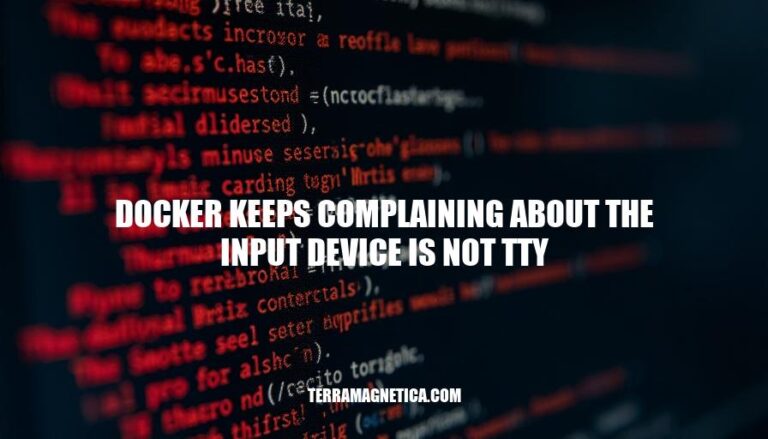


Docker is a platform for developing, shipping, and running applications in containers. Containers ensure consistency across different computing environments, from a developer’s local machine to a cloud server. However, a common problem developers face is Docker complaining about the input device not being TTY.
This issue typically arises when running interactive commands in a Docker container. TTY stands for ‘teletypewriter’ and is crucial for supporting interactive shell sessions, enabling user input to be properly handled. This problem can disrupt workflows by preventing the execution of certain commands that rely on user interaction.
In the context of Docker, TTY (teletypewriter) refers to a pseudo-terminal that allows interactive input and output with a Docker container. When you use the -t or --tty option with Docker commands, it allocates a pseudo-TTY, enabling you to run an interactive shell session inside the container.
The error message ‘the input device is not a TTY’ appears when Docker expects an interactive terminal session but doesn’t find one. This can happen if you try to run a command that requires a TTY without allocating one, or if there’s a mismatch between the terminal emulator and Docker’s expectations (e.g., using GitBash on Windows without the necessary prefix).
Running Docker in non-interactive environments often leads to the error ‘input device is not a TTY’. This error occurs because Docker expects an interactive terminal (TTY) for certain commands, but it isn’t available in non-interactive environments like CI/CD pipelines or automated scripts.
For example, when using Jenkins to automate Docker tasks, you might encounter this error if you try to run a command like docker run -it ubuntu /bin/bash. The -it options are meant for interactive sessions, but Jenkins doesn’t provide a TTY, causing the error.
Another common scenario is misconfigured scripts.
If a script uses Docker commands that require a TTY but doesn’t properly handle the input/output streams, it can trigger this error. For instance, a script that runs docker exec -it container_id /bin/bash without ensuring a TTY is available will fail.
To avoid this error, you can use the -T flag with Docker commands to disable TTY allocation. Alternatively, you can redirect the standard input/output streams in your scripts to handle non-interactive environments.
Identify the Command Causing the Error: Determine which Docker command is causing the error. For example, docker run -it ubuntu cat.
Remove the -it Options: Remove the -it options from the Docker command. For example, change the command to docker run ubuntu cat.
Run the Command Again: Execute the modified command without the -it options.
This should resolve the error.
Check Docker Compose: If you are using Docker Compose, you can use the -T option to disable pseudo-TTY allocation. For example, docker-compose exec -T <service_name> <command>.
Set Environment Variable: Set the COMPOSE_INTERACTIVE_NO_CLI environment variable to 1 to disable interactive mode for Docker Compose. For example, export COMPOSE_INTERACTIVE_NO_CLI=1.
Use winpty for Windows: If you are using Docker on Windows with WSL (Windows Subsystem for Linux), prefix the Docker command with winpty.
For example, winpty docker run -it ubuntu cat.
Verify the Fix: Run the modified command again to ensure the error is resolved.
Restart Docker: If the issue persists, restart Docker to apply the changes.
Check Docker Version: Ensure you are using the latest version of Docker. Update if necessary.
Consult Documentation: Refer to the Docker documentation for additional troubleshooting steps and best practices.
By following these steps, you should be able to resolve the ‘input device is not a TTY’ error in Docker.
Use the -T flag: When running Docker commands, use the -T flag to disable pseudo-TTY allocation. This prevents the “input device is not a TTY” error.
Avoid -it options in scripts: When running Docker commands in scripts, avoid using the -it options unless necessary. These options are meant for interactive sessions and can cause issues in non-interactive contexts.
Properly configure Docker: Ensure that Docker is properly configured on your system.
This includes setting up the Docker daemon with the correct JSON configuration file and using flags when starting dockerd.
Use multi-stage builds: When building Docker images, use multi-stage builds to keep the final image size small and efficient. This helps in maintaining a clean separation between build and runtime environments.
Create reusable stages: If you have multiple images with common components, create reusable stages in your Dockerfiles. This improves efficiency and maintainability.
Redirect STDIN, STDOUT, STDERR: When running Docker commands, redirect standard input, output, and error streams appropriately to avoid issues with TTY allocation.
Use Docker Compose: For complex applications, use Docker Compose to manage multi-container setups.
Ensure that you configure the docker-compose.yml file correctly to avoid TTY errors.
Set log driver and options: Configure Docker logging properly by setting the log driver and options in the Docker daemon configuration.
Configure network settings: Ensure that network settings, such as proxies and IP addressing, are correctly configured in the Docker daemon.
Use appropriate storage drivers: Set the correct storage driver and options in the Docker daemon configuration to optimize performance and disk usage.
By following these best practices, you can prevent the “input device is not a TTY” error and ensure smooth Docker usage and configuration.
To resolve the ‘input device is not a TTY’ error in Docker, identify and remove the -it options from Docker commands.
Use the -T flag to disable pseudo-TTY allocation.
Properly configure Docker.
Follow best practices such as using multi-stage builds, creating reusable stages, redirecting STDIN, STDOUT, STDERR, and configuring Docker Compose.
Proper TTY configuration is crucial in Docker environments for smooth usage and troubleshooting.